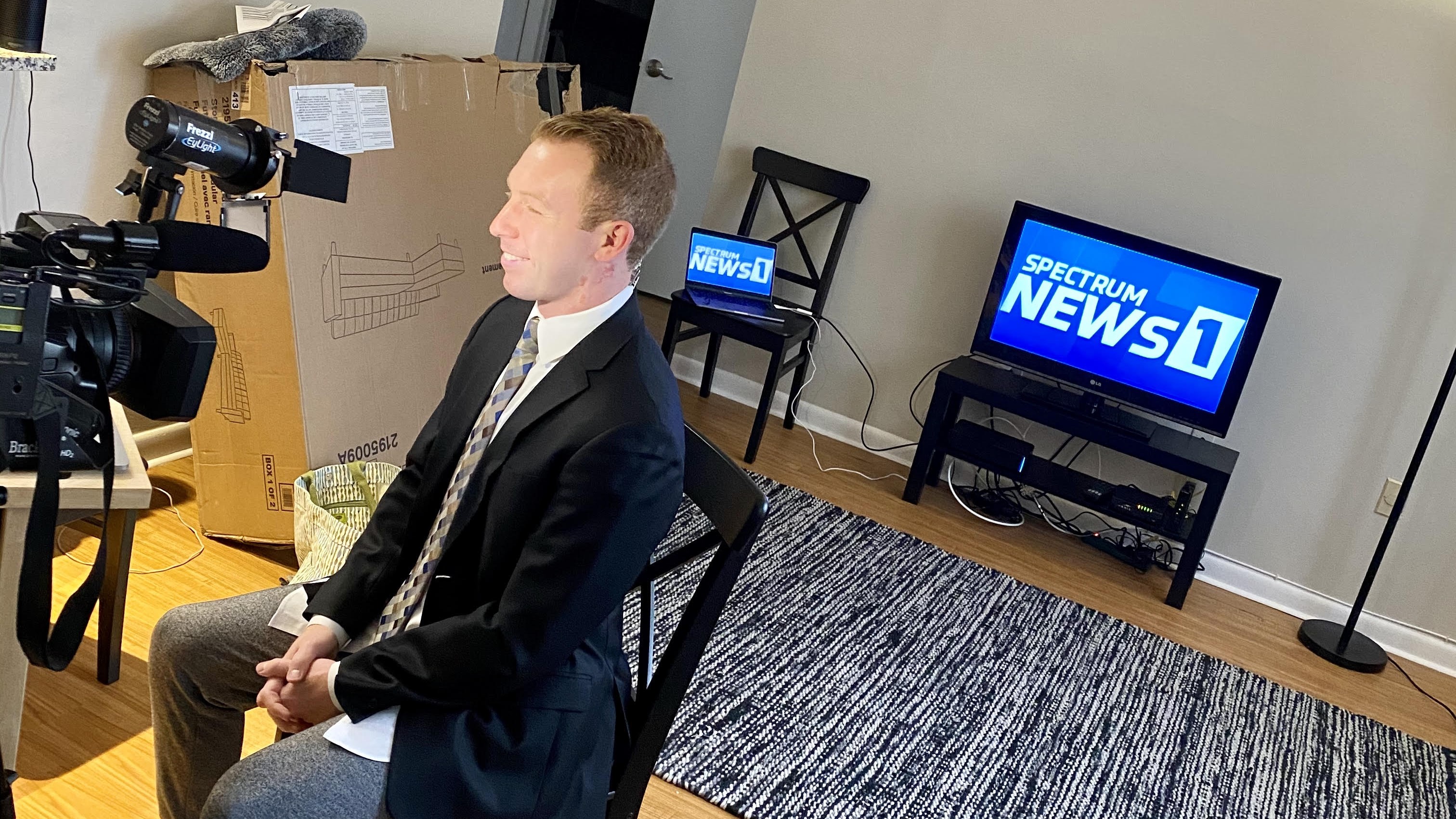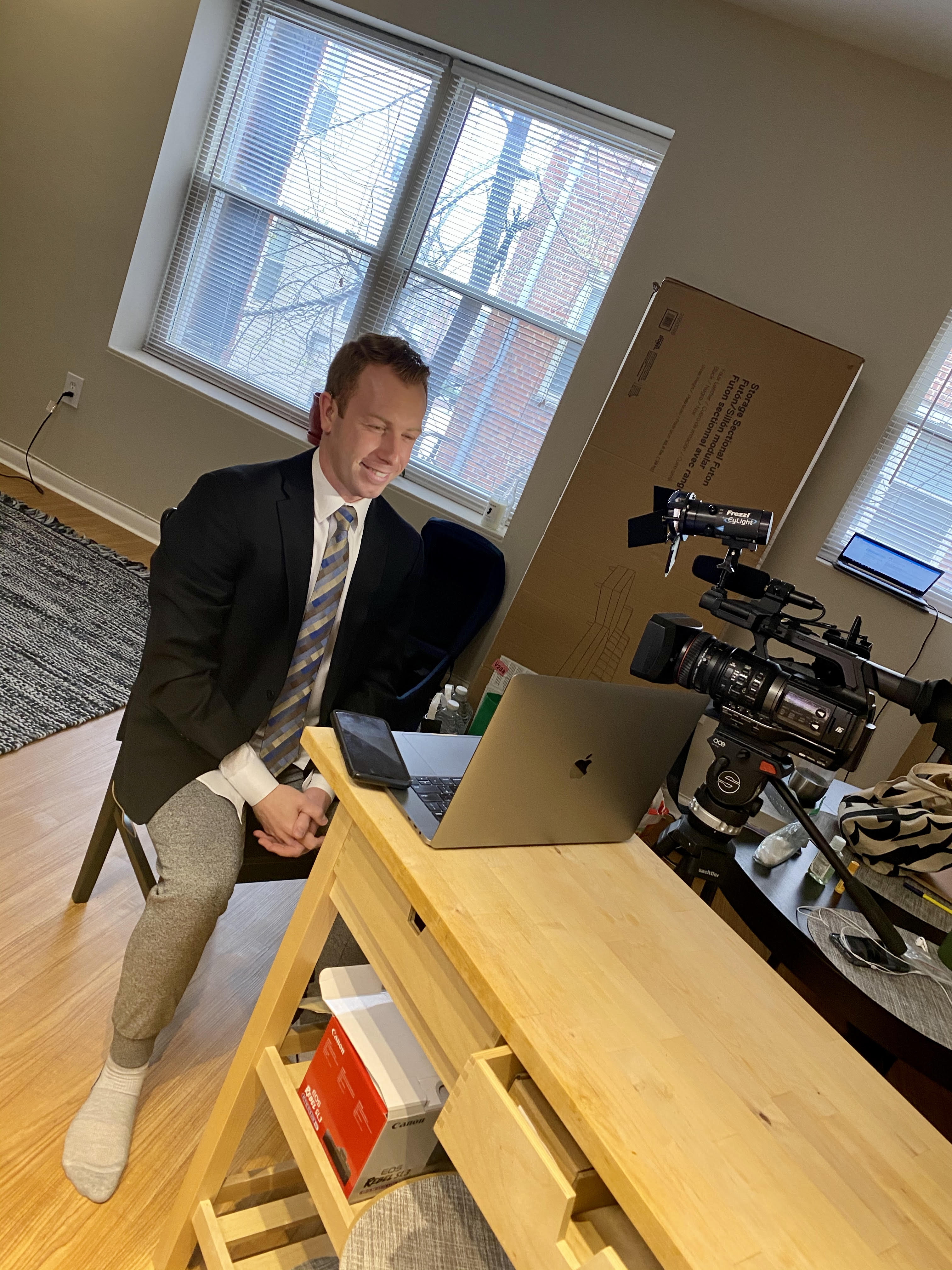So, You’re Anchoring the News from Home…
Tips on how to look and sound like a TV professional

TV anchors are suddenly delivering the news from home. Most networks and large market stations have the resources to do it well. But what happens if you work in a small market, or need to get up and running in a hurry? Here are some simple ways to get a professional look, on deadline.
Lighting is key. Don’t just turn on your living room lamp and assume it will fill the space and make you look good. Instead, set up a three-point lighting system. Use a key light on your face, a fill light on the side and a backlight to give the shot some depth. Avoid sitting under overhead lights, like chandeliers or flood lights, because those cast unpleasant shadows on your face.
Shaded lamps can work in a pinch, but a better option is to get a dimmable LED wand, studio or ring light. LEDs don’t emit heat, so you don’t have to worry about burning your hands. Plus, many come with tungsten gel filters or allow you to adjust the light’s color to give yourself a nice, soft look. And while you won’t have bright studio lights, both men and women should still apply makeup. A little foundation goes a long way in reducing glare and evening out skin tones.
Watch out for echoey spaces. Rooms with high or double-story ceilings, large empty spaces and tile or hardwood floors tend to have bad sound quality. Instead, look for smaller spaces with a lot of furniture and carpet. The idea is to minimize the distance your voice will travel and have things that will absorb sound waves instead of reflecting them.
Make sure your background is appropriate for TV. The less personal the background, the more professional your home studio will look. While you may think a certain painting, sculpture, knick knack or book cover is fine, viewers may not agree. The same goes for family pictures or vacation shots of you on the beach. Better to take them down than risk phone calls to the station.
Having your TV act as a monitor with a station logo or other full-screen image can be a great look. Devices like an Apple TV, Chromecast, Roku, Fire Stick or even a laptop can plug into your TV’s inputs to project it. But avoid having video playing if you’re not talking about what’s on the screen—the movement will be distracting. Also be sure to turn off the TV or device’s “sleep” or “screensaver” options, so you don’t suddenly lose the image while on air.

Any time you’re sitting in your anchoring chair, assume you’re on air. Follow the same rules as you would on the set or live in the field. That means not talking unless reporting or communicating with producers, not adjusting your hair or making faces, and dressing appropriately from head to toe. After all, you don’t want to stand up or have the camera slip and show everyone your pajama bottoms, or worse.
Make sure you won’t be disturbed. Use this viral video from a BBC interview as a cautionary tale for locking doors and putting up “do not enter!” signs if you live with family or friends. And if you’re broadcasting on your phone, turn off all notifications and set it to “do not disturb” so your live shot won’t be interrupted by a phone call or text message popping up on your screen. The same goes with any other phones, tablets or computers that may go “ding” in the room.
Make sure your camera or phone is on a stable surface. Unstable shots look amateurish inside your home, just like they do in the field. While a bookshelf, table, countertop or even a pile of books can work in an emergency, you can find cheap tripods online. They’ll work fine for smaller, lighter cameras, but may start to droop if you use a larger, heavier camera. And if you’re using a phone, be sure to get a tripod attachment to hold it securely in place.
Microphone-wise, it’s always best to have a lavalier mic with an adapter that lets it plug into your camera or phone. But, just like in a real studio, always check your batteries before going on air. A good second choice is a podcasting mic with an XLR or USB connector for a computer. But that won’t look as nice on air.
Similarly, an IFB that plugs into a cell phone or other streaming device will give you the cleanest on-air look. Second best are small wireless in-ear devices like Apple’s AirPods. What you want to avoid are earphones with cords, since there’s no hiding them from the camera. But in an emergency, those, along with the integrated mic in the cord, will get the job done.
If you’re broadcasting with a bonded cellular device or streaming through your laptop, it’s best to plug those devices directly into your internet router with an ethernet cable. Cellular signals aren’t as strong indoors as they are outdoors, and Wi-Fi signal strength can vary depending on where you are in your home and how many other devices are online. A direct connection will be your strongest and most stable choice, but if you must use Wi-Fi, be sure to power down any other tablets, laptops, smart TVs, smart speakers or other internet connected devices to give you as much bandwidth as possible.
You’ll also want to contact your internet service provider and ask it to boost your upload speed for better quality video. Most home plans are very skimpy when it comes to uploading data; a plan that offers more than 100 Mbps on downloads, for example, may only allow 5 Mbps on uploads. You can check your current speeds using any number of free websites or apps.
Finally, accept the fact that your home studio doesn’t need to look perfect. But it should, at least, look good.
Ben Bogardus is assistant professor of journalism at Quinnipiac University.
Get the TV Tech Newsletter
The professional video industry's #1 source for news, trends and product and tech information. Sign up below.
